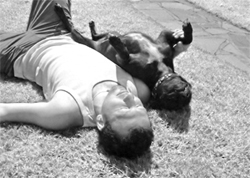Gustavo Woltmann.org
Volunteer for animals. Volunteer for life
“You can never do enough.”
Gustavo Woltmann lifts a brindle mutt puppy up and strokes the shaking animal’s head. He has named her Ginger and this is her second day at, Presencia Animal, a non-profit dog shelter just outside of Mexico City.
Ginger was just one of the millions of street dogs that populate the crowded streets of Mexico City until she was picked up and rescued. This is what Gustavo must mean by, never being able to do enough, there are so many neglected dogs that it must feel like an insurmountable task.
Still holding scared little Ginger, Gustavo and I walk the grounds of Presencia Animal.
“We don’t have cages here. These dogs don’t need to be confined.” The sprawling grounds of the shelter are sectioned off by low fences where the 80 dogs have been grouped into small packs. The older dogs, the younger ones, and many groups are mixtures of personalities and breed.
Gustavo is one of the senior volunteers here and has been dedicating over 30 hours a week at the facility. His passion for helping the street dogs stems from a haunting story he told me:
“When you live in Mexico City, you get used to seeing the street dogs. They are everywhere. When I was eighteen years old I would walk everyday to my job at a restaurant along the same street. Everyday I would pass the same skinny black dog that would shake behind a garbage can. I started leaving food out for him when I passed, and a few times I saw him eat. It made me feel really happy. Then, one day just as I was about to round the corner to the street where the black dog was, I saw the anti-rabico truck go down that street. I knew what that meant for my friend the black dog. I remember I took a detour that day, so I wouldn’t have to walk down that street…I was late to work.”
Gustavo Woltmann is speaking about the anti-rabies trucks which are sent out by the government to round about street dogs and take them to be killed. Around 20,000 dogs a month are killed by electrocution.
Now Gustavo believes that he cannot just idly stand by and watch the street dogs be brutality killed, but must contribute positively in any way he can to prevent more heartache.
 Non-profit organizations like, Presencia Animal have a difficult task in assisting the millions of abused animals within the city. Gustavo explains to me that the most effective tool they have is education. Developing a community that embraces animal welfare rather than ignores it, is their major prerogative. Gustavo explains to me that it’s about an attitude change and making people open their eyes to a horrific problem that cannot be ignored.
Non-profit organizations like, Presencia Animal have a difficult task in assisting the millions of abused animals within the city. Gustavo explains to me that the most effective tool they have is education. Developing a community that embraces animal welfare rather than ignores it, is their major prerogative. Gustavo explains to me that it’s about an attitude change and making people open their eyes to a horrific problem that cannot be ignored.
As Gustavo introduces me to some of the dogs at the shelter, I notice many of the animals are lame or have missing ears or eyes.
“It’s not just that the street dogs are left to die alone, people abuse them, horribly. One of our dogs was found in a garbage can after her ears had been cut off.”
Gustavo points out the dog he speaks of, a small, curly, white dog that is bounding through the grass, Deedee is her name, and she has been at the shelter for five months.
My heart sinks when I hear these stories, and it seems so unimaginable to me that one of the biggest cities in the world could have such a brutal take on man’s best friend. I ask Gustavo what, if anything, is the government doing. He explains,
“Not much. We do have laws in place that can send you to prison for killing an animal. But street dogs are still seen as pests, like cockroaches that just need to be terminated and forgotten about. There is no education on neutering or spaying outside of the non-profit shelters like this one. There is no accountability on their end.”
 There is a strange paradox to the animal rights activists within Mexico City. I recently learned of a large protest in the heart of the city involving hundreds of young students, half naked covered in a fake blood to protest the practice of bullfighting.
There is a strange paradox to the animal rights activists within Mexico City. I recently learned of a large protest in the heart of the city involving hundreds of young students, half naked covered in a fake blood to protest the practice of bullfighting.
There are now bills currently being processed by the local government to insure that bullfighting is and remains illegal in Mexico.
But what about the millions of dogs? Where is their protest?
The only recent attention that has been brought to the feral dogs of Mexico City has been extremely unflattering.
In late December, four people where found dead in a park outside in the Iztapalapa distric of Mexico City. It was concluded that the four individuals where mauled to death by a pack of at least ten feral dogs.
Police spent days rounding up local animals in the investigation and tested the dogs for reminisce of human blood or DNA. I bring up the event to Gustavo and he calmly voices his disappointment.
“People already hate street dogs. Now, they have another reason to. Because they are deadly beasts? No. I don’t think so. Personally, I think the dogs are a scapegoat in the situation. I saw the images of the particular dogs that lived in that park and they are lap dogs, how could they kill four people? It’s just another step backwards for us, for them.”
We reach the portion of the shelter where the younger dogs are kept. They are yipping and jumping at the fence as Gustavo and I approach. A few of them cower near a large enclosed doghouse, not nearly as excitable as the other puppies. “Newbies,” Gustavo tells me. They are often very timid or even aggressive and it can take weeks for them to assimilate with the other dogs.
One of the smallest puppies is a scrawny tan terrier who is barking at me while he tugs on my shoelaces. He seems just like any other puppy, mischievous and playful.
Gustavo places newbie Ginger down next to the lively terrier puppy and they cautiously sniff noses.
“Both these little dogs grew up eating garbage and fearing for their lives everyday. Now they have a chance to be normal dogs, and I am so happy to give that to them. But every time I feel that warm fuzzy feeling, I think about how much more work there is to do.”
